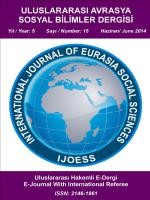ORTA ASYA’DAN MEZOPOTAMYA’YA SUMER GÖÇLERİ VE KÜLTÜREL ETKİLERİ
Sumerıans are a people came migratory routes Mesopotamia. Their migration is dated to the periods of centuries ago. Region of origin contributed to the development of civilization. There are various opinions about the arrival routes to Mesopotamia. They gain weight around the opinion of the Caspian Sea and Aral Sea. Sumerians developed their own unique writing and language. Language is Ural-Altaic group. Therefore the Central Asian origin are thought to be a people. Turks that they were the Sumerians was put forward some theses. In this thesis, the history, culture, language, traditions, burial customs, and so on as may be approved. Sumerians, who migrated from Central Asia to Mesopotamia, is an example of nomadic Turkish tribes. Sumerian culture has been moved to Europe as a result of migration.
SUMERIAN MIGRATIONS FROM CENTRAL ASIA TO MESOPOTAMIA AND CULTURAL INTERACTION
Sumerıans are a people came migratory routes Mesopotamia. Their migration is dated to the periods of centuries ago. Region of origin contributed to the development of civilization. There are various opinions about the arrival routes to Mesopotamia. They gain weight around the opinion of the Caspian Sea and Aral Sea. Sumerians developed their own unique writing and language. Language is Ural-Altaic group. Therefore the Central Asian origin are thought to be a people. Turks that they were the Sumerians was put forward some theses. In this thesis, the history, culture, language, traditions, burial customs, and so on as may be approved. Sumerians, who migrated from Central Asia to Mesopotamia, is an example of nomadic Turkish tribes. Sumerian culture has been moved to Europe as a result of migration
Keywords:
Central Asia, Sumerian, Text, Language, Migration, Cultural İnteraction,
___
- AKDOĞAN, B. (2008). “Türk Din Musikisi Tarihine Bir Bakış”, Ankara Üniversitesi İlahiyat Fakültesi Dergisi, C. 49, S. 1, Ankara: Ankara Üniversitesi Basımevi, s. 151-190.
- BİLGİÇ, E. (1982). “Atatürk, Fakültemiz ve Kürsümüz Sumerlilerin Tarih, Kültür ve Medeniyetleri”, DTCF Atatürk’ün 100. Doğum Yılına Armağan Dergisi Ayrıbasım, Ankara: Ankara Üniversitesi Basımevi, s. 75-121.
- ÇEÇEN, S. GÖKÇEK, L. G. (2005). “Sumerce’de Kültür Tarihimize Dair İzler”, Akademi Günlüğü Toplumsal Araştırmalar Dergisi, C. I, S. 1, Ankara: Siyasal Kitabevi Yayınları, s. 1-7.
- ÇIĞ, M. İ. (1994). “Sumerlilerden Zamanımıza Ulaşan Kültür İzleri”, XI. TTKB, (Ankara: 5-9 Eylül 1990), C. I, Ankara: Türk Tarih Kurumu Basımevi, s. 235-246.
- DURMUŞ, İ. (2006). “Milattan Önceki Dönemlerde Anadolu’da Türk Varlığı”, Uluslararası Askeri Tarih Dergisi, S. 87, Ankara, s. 1-13.
- DURMUŞ, İ. (1993). İskitler (Sakalar), Ankara: Türk Kültürünü Araştırma Enstitüsü Yayınları. ERCİLASUN, A. B. (2010). “Tarihten Geleceğe Türk Dili”, (erişim) http://turkoloji.cu.edu.tr/ESKI%20TURK%20DILI/7.php 31 Aralık 2010.
- GÜNBATTI, C. (2007). Sumerler, Gutlar, Hattiler, Huriler, Urartular Kökenleri, Tarihleri, Dilleri ve Kültürleri, Ankara: Genelkurmay Askeri Tarih ve Stratejik Etüt Başkanlığı Yayınları.
- HATİBOĞLU, V. (1979). “Türk Tarihinin Başlangıcı”, Türkoloji Dergisi, C. 8, Ankara: Ankara Üniversitesi Basımevi, s. 29-52.
- KOCA, S. (1992). “Eski Mezopotamya’da Tarih, Kültür ve Medeniyet”, Türk Yurdu Dergisi, C. 12, Ankara, s. 38-44.
- KOCA, S.(1990). Türk Kültürünün Temelleri-1, İstanbul: Damla Neşriyat.
- KRAMER, S. N. (2002) Sümerler Tarihleri, Kültürleri ve Karakterleri, Çev: Özcan Buse, İstanbul: Kabalcı Yayınevi.
- LANDSBERGER, B. (1943). “Sümerler”, DTCFD, C. I, S. 5, Ankara, s. 89-96.
- UHLIG, H. (2006). Tarihin Başlangıcında Bir Halk Sümerler, Çev: Nilgün Ersoy, İstanbul: Telos Yayıncılık.
- ISSN: 2146-1961
- Başlangıç: 2015
- Yayıncı: Kadir ULUSOY
